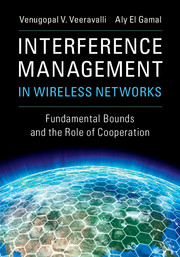Book contents
- Frontmatter
- Contents
- Preface
- Acknowledgments
- 1 Introduction to Interference Management
- 2 System Model and Sum Capacity Characterization
- 3 Degrees of Freedom and Interference Alignment
- 4 Iterative Algorithms for Interference Management
- 5 Degrees of Freedom with Coordinated Multi-Point Transmission
- 6 Locally Connected Channels with CoMP
- 7 Backhaul Load Constraint
- 8 Cellular Uplink
- 9 Dynamic Interference Management
- 10 Recent Advances and Open Problems
- Appendix A Information Theory
- Appendix B Algebraic Geometry
- References
- Index
8 - Cellular Uplink
Published online by Cambridge University Press: 09 February 2018
- Frontmatter
- Contents
- Preface
- Acknowledgments
- 1 Introduction to Interference Management
- 2 System Model and Sum Capacity Characterization
- 3 Degrees of Freedom and Interference Alignment
- 4 Iterative Algorithms for Interference Management
- 5 Degrees of Freedom with Coordinated Multi-Point Transmission
- 6 Locally Connected Channels with CoMP
- 7 Backhaul Load Constraint
- 8 Cellular Uplink
- 9 Dynamic Interference Management
- 10 Recent Advances and Open Problems
- Appendix A Information Theory
- Appendix B Algebraic Geometry
- References
- Index
Summary
Our treatment of the CoMP concept of communication has been restricted so far to transmission schemes and their applications in the cellular downlink. In this chapter, we investigate whether the ideas studied for enabling rate gains and minimizing delay requirements through CoMP can be applied to reception schemes and their applications in the cellular uplink. Throughout our discussion of CoMP transmission, we assumed that messages are distributed through a backhaul network to transmitters. More specifically, we assumed that sharing of information between transmitters occurs through sharing of digital messages, instead of assuming that quantized analog signals are being shared. This is a natural assumption when considering the cellular downlink for the following reasons. First, sharing of analog signals is prone to quantization errors, which complicate the interference management problem, and make it harder to obtain clear insights through information-theoretic analyses. Second, since our purpose is to model fairly general scenarios for cellular networks, and in particular, those anticipated in next generation wireless networks, it is natural to assume that a message is being delivered from a central controller (or basestation controller) to each basestation transmitter. This is the case even if we are not considering cooperative transmission, and hence it is also natural to extend this assumption with a more powerful backhaul to allow for delivering the digital message to more than one basestation transmitter. For the considered setting of cellular uplink, the first reason mentioned above will still hold. However, the second aspect is different. Here, we can think of two different ways for cooperative reception. The first is when sharing of analog received signals is permitted; we call such schemes CoMP reception schemes and we discuss information-theoretic results for this case in Section 8.1. The second is when only sharing of decoded messages is permitted; we call this the message passing model and we discuss information-theoretic results for this case in Section 8.2.
There are noticeable similarities between the message passing model and the CoMP transmission schemes that are based on zero-forcing. By passing one message from one basestation to another through the backhaul, the interference caused by this message at exactly one receiver could be eliminated. However, unlike the downlink case, when the interference caused by a message is canceled at one receiver through cooperation, it does not propagate to other receivers.
- Type
- Chapter
- Information
- Interference Management in Wireless NetworksFundamental Bounds and the Role of Cooperation, pp. 148 - 164Publisher: Cambridge University PressPrint publication year: 2018

